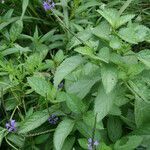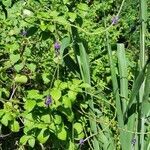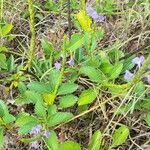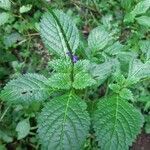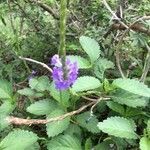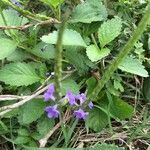Shrub 0.3–1.2 (–2) m high, low, sprawling. Stem purplish or yellowish brown, ±terete, glabrous. Leaves subsessile to shortly petiolate; petiole 5–30 mm long; lamina obovate to oblong-elliptic, 20–100 mm long, 10–50 mm wide, attenuate into petiole, serrate to dentate, fleshy when fresh, chartaceous-subcoriaceous when dry. Spikes stout, firm, 150–500 mm long, (2–) 3–5 (–7) mm mm diam., glabrous; rhachis furrows narrower than mature rachis; bracts ovate-elliptic or narrowly oblong-ovate, 4–8 mm long, 1.5–2.5 mm wide. Calyx ± compressed, 4-costate, 5–7 mm long, glabrous apart from lobes. Corolla mauve-blue, hypocrateriform; tube cylindrical, 7–11 mm long, pilose internally in upper half; limb 6 mm diam. Stamens inserted in corolla throat. Ovary oblong, glabrous; style 6–9 mm long. Fruit oblong, somewhat compressed, 3–7 mm long, blackish brown.
Perennial well-branched herb 0.6–1.2 m. tall, woody at base; stems glabrous or very slightly pubescent, rarely more distinctly hairy on the young shoots, often purplish.. Leaves ovate, elliptic or ± oblong, 1.5–11 cm. long, 0.8–5 cm. wide, ± obtuse in outline at apex, long-attenuate into ± 1 cm. long petiole at base.. Spikes long and narrow, 14–45(–50) cm. long, glabrous; bracts lanceolate or oblong-lanceolate, 5–8 mm. long, 2 mm. wide, acuminate.. Calyx tubular, 5–6.5 mm. long, bifid at apex, 4-toothed, the 2 central teeth rather shorter.. Corolla pale blue to deep or royal blue or purple, sometimes with a white centre; tube 0.8–1.1 cm. long, slightly curved; limb ± 8 mm. diameter, the lobes ± 3 mm. long.. Stigrna included.. Mericarps dark, linear-oblong, 4(–?7) mm. long, 1 mm. wide, dorsally ribbed.
A herb which keeps growing from year to year. The branches curve upwards. It grows to 1.5 m high. The leaves are produced opposite one another on winged stalks. The leaves are oval and 4-10 cm long. They have forward facing teeth. The flowers occur as a spike at the end of the plant. The stalk is thickened and the flowers arise from depressions in it. The flower forms a tube towards its base and is purplish-blue. This stalk thickens more and the fruit are about 3.5 mm long in the depressions. They form 2 nutlets. The inner side of each one is flat.
Subshrubs or robust perennial herbs, 0.6-2 m tall. Branches 4-angled when young, sparsely pubescent to subglabrous. Petiole winged; leaf blade elliptic to oblong-ovate, 2.4-8 X 4.5 cm, papery, subglabrous, base elongated, margin serrate, apex acuminate, veins 5 or 6 pairs. Spikes few to 20 cm or longer; bracts ca. 5 mm, membranous. Calyx ca. 6 mm, glabrous. Corolla dark blue; tube 7-12 mm, slightly curved. Capsules included in calyx.
Leaves petiolate, lamina 2–9(11) × 1.2–5.5 cm, elliptic, oblong, obovate or spathulate, obtuse to rounded or somewhat acute at the apex, attenuate and decurrent into the petiole or ± rounded and abruptly narrowed and narrowly tapering-cuneate into the petiole, crenate-dentate on the margin with 7–15 teeth on each side, entire below, glabrous on both surfaces or with sparse hairs on the nerves beneath; petiole up to c. 1 cm long.
Spikes slender, 14–45(50) cm long, up to 4 mm thick in fruit, glabrous; bracts 5–8 × 2–2.5 mm, ± as broad as the fruiting calyx, lanceolate or ovate-lanceolate, apically attenuate, not longer than the fruiting calyx, striate, scarious on the margins, glabrous, not thickened or a very little so at the base.
Corolla blue, violet or nearly white; tube 8–11 mm long, slightly curved, exserted up to c. 5 mm above the calyx; limb c. 9 mm in diameter, the lobes c. 3 mm long.
A perennial herb or subshrub, 0.3–1.2 m high, woody at the base, ± sparsely pubescent mainly on the young parts, glabrescent on older parts.
Calyx 5–6 × 2.5 mm, tubular, ellipsoid, bifid and without peltate glands at the apex, 4-toothed, the 2 central teeth rather shorter.
Style exserted 3–4 mm above the calyx after the fall of the corolla.
Fruiting calyx ± completely embedded in the furrows of the rhachis.
Stem and branches pilose at the nodes, often purplish.
Mericarps c. 7 mm long.
